|
Forfarshire has three
ports, Dundee, Montrose, and Arbroath. Dundee ranks third amongst
the ports of Scotland.
Previous to the
discovery of America the east coast of Scotland, as facing the
Continent, was far more important in its shipping than the west. By
1354 shipping at Dundee had grown to such dimensions as to require
special officials to collect the shore dues and customs. In 1447,
James II issued letters patent, authorising dues to be raised on
vessels frequenting the port so that its harbour might be kept in
good repair. In those days French and Rhenish wines seem to have
been largely imported at Dundee. In 1654 Dundee owned 10 vessels; in
1691, 21; and in 1792, 116, of which 78 were coasters, 34 foreign
traders, and four whalers. Between 1700 and 1814 the harbour was
managed by the Town Council, who instead of applying the dues to its
improvement, devoted wthin that period nearly £30,000 of harbour
money to general town purposes. In 1815 the First Harbour Act
transferred the management to the Harbour Commissioners until 1836,
when the Harbour Hoard was permanently constituted on a popular
basis.
Meanwhile
improvements and extensions on plans drawn up by Telford were being
carried out at a cost of £90,000, and the Graving Dock and the King
William IV Dock were opened. In 1832 another—the Earl Grey -—dock
was added. The i6i acres of dock accommodation thus secured sufficed
for the coasting trade until 1865. In that year the Camperdown Dock
was constructed and the Victoria Dock in 1869, which increased the
acreage of the harbour by 19½ acres. The main reason for the
construction of these new works was the direct importation of jute
from India; and to-day, such has been the increase of the tonnage of
the jute fleet, these spacious basins are quite inadequate. Besides
a special Fish Dock for the reception of trawlers and other fishing
vessels, 2800 feet of deep river wharves have been built where the
largest jute steamers can lie and discharge at any state of the
tide. Since these arrangements were completed the measurement of
vessels entering the port has increased by more than 100,000 tons,
and the Commissioners have now in view a further extension of the
harbour. Its present dimensions are :—
Area of docks 38.5 acres.
Quayage 17,875 feet.
Shed accommodation 55,889 sq. yds.
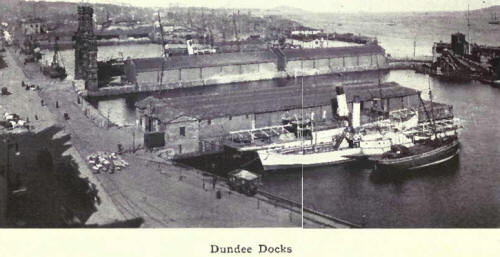
The following figures show the number
and tonnage of vessels entering the harbour in 1911 :—

The steamers carrying
jute are about 50 in number and their average tonnage about 6000.
There is regular communication with Newcastle, Hull, London, and
continental ports.
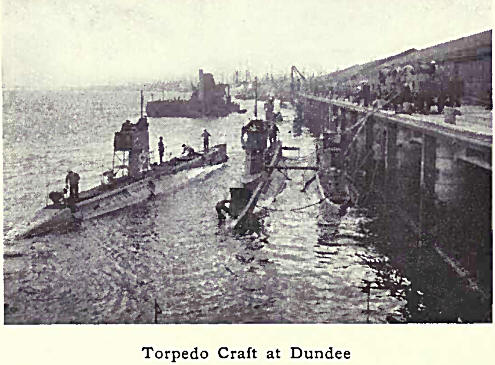
The harbour is
equipped with hydraulic discharging appliances. The system of using
light portable jiggers can be seen in no other port in the world.
The coal hoist, 70 feet high, is the largest on the east coast and
can ship 200 tons per hour.
The strategical
importance of the Tay has recently been recognised by the Admiralty,
who have formed a submarine depot at Dundee. Nearly a score of naval
vessels, submarines, and torpedo boats have made the port their
headquarters.
The revenue and the
expenditure of the harbour of Dundee have steadily increased: in
1858 they were respectively £25,045 and £21,544; in 1909, £80,420
and £73,733. The following tables of imports and exports give the
best idea of the trade of the port and city:—
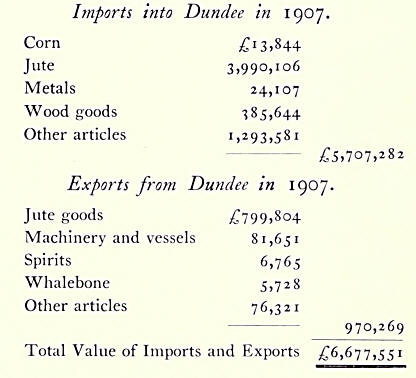
Montrose is a very old port. In 1330 Sir
James Douglas embarked there, carrying with him the heart of the
Bruce. The annual tonnage of ships entering Montrose is about 80,000
and that of ships leaving the port about 30,000.
The imports and
exports for 1906 are as follows:—
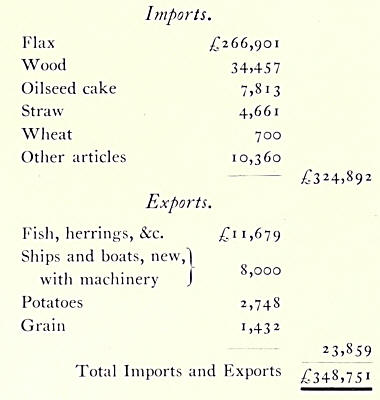
In connection with these figures some of
the fluctuations in trade for the four last years should be pointed
out. In 1910 the importation of wheat rose to £5590, while that of
oilseed cake fell to £2321; amongst the exports, ships and boats
rose in 1908 to £27,052, while no return was made for them in 1910.
The number of barrels of herring exported from 1906 to 1910 were for
the successive years 9141, 15,364, 8988, 2142, 11,758.
The original harbour
of Arbroath was superseded in the eighteenth century by one more
commodious a little to the west, which in turn was enlarged and
improved about 1844 at a cost of £50,000. Since then the entrance
has been deepened and a wet dock constructed. The imports and
exports for 1907 are as follows: —
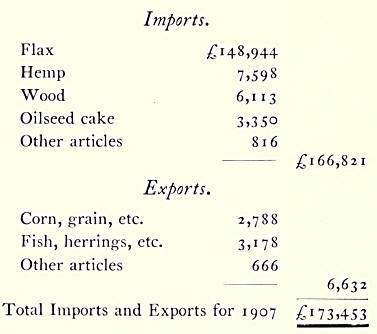 |

